Trujillo, Peru – The first thing I noticed about Trujillo was the traffic. Both pedestrian and vehicle, Trujillo has to have the most swirling maelstrom of movement that I’ve encountered, pretty much anywhere. Being a fairly poor community, it’s not surprising that it’s rare for individuals to own cars, but I expected far more in the way of micros (small buses) and combis (vans) running around providing public transportation. And it’s not that they’re not there, they are, especially as you get outside the center of town, but the surprise for me was the sheer number of taxis. For a town of 400 and some thousand, it seems at times that there must be a taxi available for every family living there. And did I mention the craziness of drivers in some of the other spots we’ve visited on this trip? I think so. None of them (well, maybe the Machu Picchu bus drivers) hold a candle to the taxi, micro, and combi drivers here. They slalom through the streets like they’re the only one there and they’re on a race course. Standing back, you’d swear they’re all drunk (and, it turns out, many are – beer consumption here is astounding – one of Henry’s brother-in-laws and one of his nephews both drive cabs… at one lunch, the two of them shared 14, yes, 14, 620ml bottles of beer, and then went back out to work – and it’s a common sight to see folks actively drinking and driving). Accidents are common, but unremarkable – they bounce off of each other like bumper cars at an amusement park, and as long as no one in their own vehicle is hurt, they simply drive away. During the week we were there, the two mentioned relatives above were involved in three accidents, two with other cabs, one with a van. They simply couldn’t have cared less.
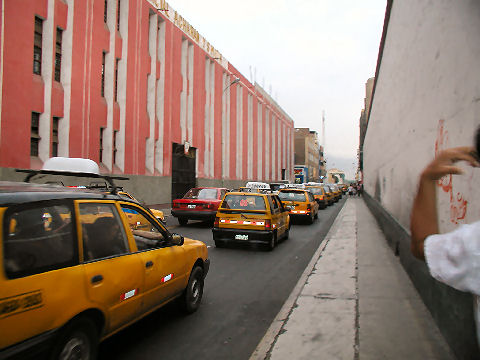
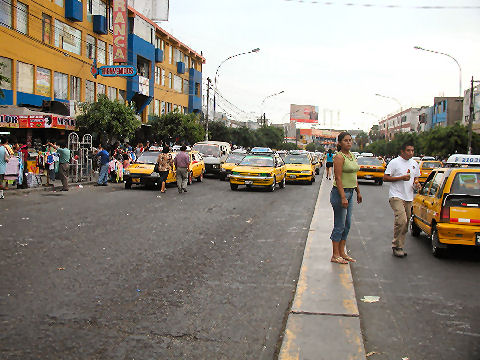
The second thing I noticed in town is the dichotomy between the central core of the city and its surrounds. Originally, Trujillo was a Spanish fortress, encompassing an area shaped in an oval, roughly 8 x 10 blocks, completely walled in, with guard towers, etc… Parts of the wall are still there. In the center of town, while busy, bustling, and somewhat rundown, and not particularly clean, the architecture is fairly Spanish colonial in style, and, of course, centered around a classic main square in the heart of the oval that contains the main administrative buildings and the cathedral. As soon as you cross Av. España, the street that encircles the former fort, there’s a drastic change. It pretty much seems as if the rest of the town is poverty stricken barrios. Construction is as basic as it can get, services are few, and I was repeatedly warned about the lack of safety, especially for a tourist. Even Henry’s family, whom we spent most of the week visiting, are careful when they go outside anywhere beyond the block they live on where they know everyone.
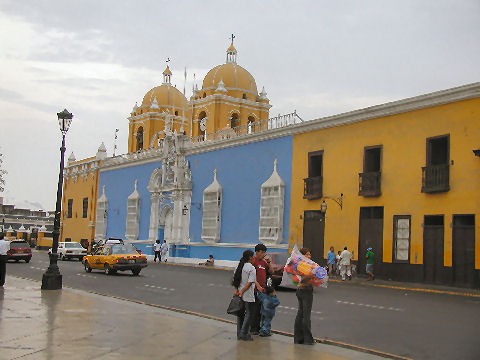
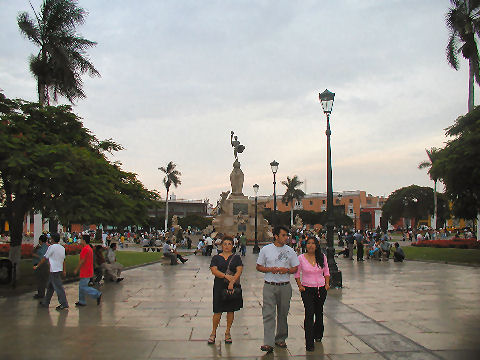
And that leads to some thoughts about the people who live in Trujillo. I can’t generalize, I didn’t meet them all, obviously. But there’s a strong element of “every man for himself” that seems to pervade the town and any interactions that one might have. The idea of cheating someone, lying to them, stealing from them, seems to be a part of the fabric of the society – and that’s not something that’s unique to Trujillo as a poverty-stricken community, but at the same time, it’s not something universal to the world of poverty. This atmosphere is accompanied by an attitude of what in Argentina is called sin verguenza, or without shame. As an example, and it’s just a personal one, we went to one of the beaches near town one day – packed the whole family and a bunch of neighbors into a van and headed out. We were all having a good time, but given the general safety level, it was made clear that one or more family members of friends stayed with everyone’s bags while others frolicked in the waves – and everyone took turns. At some point during that, while a couple of neighbors were guarding the bags, they simply went through Henry’s and my bags, us being the “rich tourists” apparently, and took all of our money (thankfully not all of what we had was with us, but it was still nearly 500 soles, or about $160). When we discovered it (when we went to pay the driver for the ride and had to scramble to find a way to pay him), they simply shrugged and said that the beach was a dangerous place, and walked off to their respective homes. And though the family put on a show of hue and cry, by the next day, everyone was hanging out together again. Needless to say, not comfortable for me, and upsetting for Henry.
And there’s no relief in the form of official presence. The police are openly just as bad. They set up roadblocks throughout the city and randomly stop cars, confiscating everyone’s identification papers, and demand money to return them. There’s always, of course, some infraction that is cited – a broken headlight, someone not wearing a seatbelt, too many people in the vehicle – but the amazing thing is the audacity with which they simply stand there and state their price to return people’s papers and not lock them up (and yes, it happened to us). Fascinatingly, in some ways, we happened to pass by a “police fair”, where the various divisions of the force were out recruiting – the fair was packed with people all eagerly filling out paperwork… it became clear after a week in Trujillo, that they simply want to be the ones in a position to demand money from their own neighbors… and get away with it.
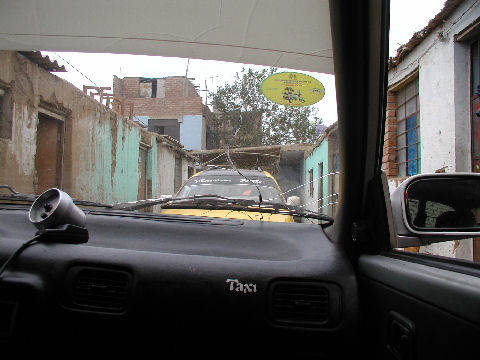
Enough on that for now… and back to impressions of the city – it’s a coastal city, so built on a lot of sand (things like cemeteries are all above ground, because wet sand is difficult, I gather, to bury people in), and it’s also subject to earthquakes, which thankfully didn’t happen while we were there, but apparently happen regularly. It also gets hit by various other things – while we were there there was a bit of a scare of dengue fever, that turned out, luckily, to be far less widespread than first thought, though the city still was putting major efforts into making sure there were no puddles of stagnant water left around, and warning people to not leave pots of water open outside. Anyway, being coastal, Trujillo is blessed by some beautiful beaches, including the famous Huanchaco, a bit touristy, but still frequented by locals, where you can watch (or take a ride) the caballitos de tortora, or reed boats, ply the waves.
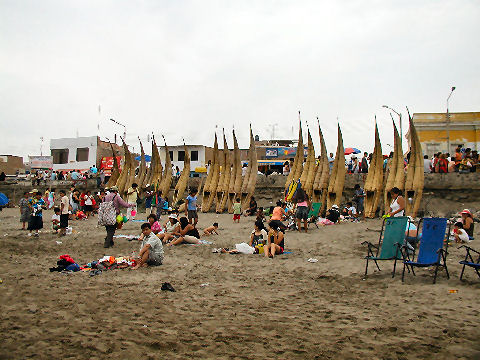
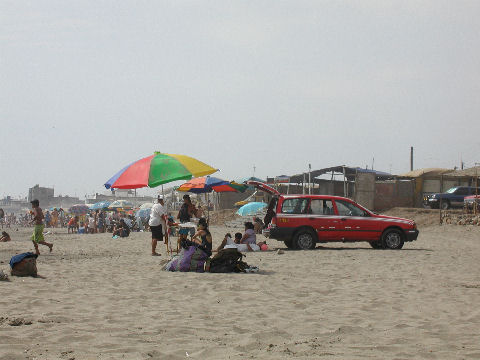
This seems like it would be a depressing place in which to live, and not necessarily because of the poverty. The attitude you describe among the inhabitants isn’t one I could live with.
Me either, I found it very wearing… when we arrived in Lima last night, I just sort of collapsed, but it was more out of relief of being out of that atmosphere than anything else.
I’ll get into more of a discussion of this in a coming post, but the interesting thing about this despair, and level of living in abject poverty, and attitude, is that it’s something they’re all very aware of. They also blame it on the Spanish conquistadors. You know, they arrived, and forced us into submission, forced us to become catholics, and left us in poverty, built all these colonial buildings, and built a fort (uhh, the fort is long gone folks… other than a few pieces of the wall still standing as historical monuments) and now we’re stuck this way and there’s nothing we can do about it because we’re so oppressed by the conquistadors. Gee folks, that was 600 years ago… maybe it’s about time to get on with things in your city? They seem to be making a go of it in other cities in your country…
Yes, Dan. But just like individuals, social groups are often reluctant to adopt change because that would mean some hard, challenging work. It’s far easier to maintain inertia.
I don’t know how I would have reacted if a close friend’s family were so blatant about robbing me. Things that come to mind are: murderous rage, temporary insanity and seeing if those joint locks I learned in martial arts really do break bones.
[…] pictured it slightly inland. After all, when anyone talks about going to the beach, they talk about Huanchaco. Then again, Playa Buenos Aires is not much of a […]
[…] Henry’s family in Trujillo. Things have come a long way since my first time nine years ago. (Here, here, here and here.) Bit by bit, Henry has been helping his family out – the house that I […]